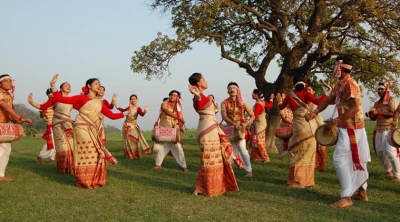
Bohag Bihu is the widely celebrated across Assam, and parts of Manipur and Bengal. The Assamese celebrate Bihu thrice a year, which signify the distinct cycles of farming – Bhogali/Magh Bihu (January), Bohag/Rongali Bihu (April), and Kongali Bihu (October).
On the day of Bohag Bihu, various delicacies like Mangsho, Chira and Pitha are made. Women, men and children are seen singing, feasting, exchanging gifts, seeking blessings from elders, wearing new clothes, and performing the traditional Bihu dance on this day.
Bihu celebrations start from newy year day itself and last for seven days with each day having its own charm and significance. Bihu celebrations do not last for just one day but are observed for seven days in which every day has its own significance. People take bath early in the morning while applying raw turmeric and urad dal. Bathing is followed by wearing traditional dresses and preparations for rituals. Bihu dance is a mandatory ritual in Bihu celebration wherein people dance for the whole day and sing folk songs. They express gratitude to God and nature for their blessings and pray for a good harvest, prosperity and peace.
The festival is significant because of the belief that prayers made on this day get heard and bring joy, happiness and prosperity. Negativity goes away and physical and mental peace is ensured.
Picture Credit : Google
